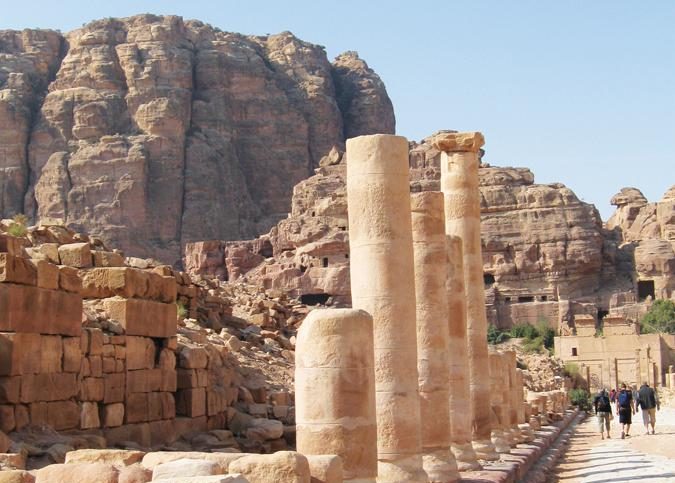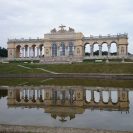by Carmen Loren
Upon arriving in Wadi Musa, Jordan, I am faced with a choice: to hike or not to hike to Petra in the dark? Despite the chill and my weariness, I opt for the former and spend the next few hours in a state somewhere between awe and bliss.
As I follow a winding candle-lined path all the way to the famous Treasury, with nothing but the 1500 flickering flames to light the way, I am overwhelmed by how surreally beautiful the towering rocks look at night: They reflect the light of the moon and the stars, taking on an almost phosphorescent quality and lending an air of deep mystery to everything around them. Despite our guide’s warning to the contrary, I spend a significant part of the walk with my eyes trained on the sky, marveling at the multitude of clearly visible constellations and at the silver silhouettes of the rock formations towering above me.
After years of yearning to see the rose-red marvel that is the Treasury, I am not disappointed. While at night it lacks the translucent glow for which it is famous, the Treasury, bathed in the golden light of hundreds of candles, takes my breath away. Its graceful columns and sheer size do not fail to impress, even in near darkness, and as I sit on my straw mat, listening to the haunting strains of Bedouin music, I feel very small, very young, and very insignificant. Yet my soul feels fuller somehow, and I am certain that I will never forget just how beautiful and devastatingly romantic this night is.
The next morning, as I pass through the gate for the second time in less than twelve hours, I find myself wondering how the Nabataeans came to choose this particular location for their city. Was it merely a convenient spot, or were people 2000 years ago just as stunned by the dramatic rock formations as their modern counterparts? Did desert wanderers look at the play of light and shadow on the reddish stone and feel irresistibly drawn to the place? Were they as fascinated as I am by the way the moving sun seems to change the very shape of the surrounding cliffs?
As it turns out, one can hire a horse and ride it to the Siq’s entrance. The Indiana Jones in me perks up; I hire a gorgeous chestnut and gallop happily all the way to the Siq, eager to get to the Treasury before the 09:00 magic hour (who doesn’t want perfect light when photo ops abound?). As I proceed, the Siq seems to narrow. At last, just when I begin to get used to the twists and turns, one final bend reveals what looks like a pink gash in the rock.
The Treasury itself (the locals call it Al Khazna) is, to put it mildly, magnificent. I stand in the crowded courtyard, mouth agape, and stare at what can only be described as an exquisite work of art of gargantuan proportions. I take a few pictures, but mostly I just stand and try to take in every inch of the beautiful monument before me. My eyes drink in every detail as I’m jostled and bumped by the clusters of tourists, guides, and animals that mill around.
To me, the Treasury seems to be carved out of porcelain – or maybe out of the delicate peachy-pink inside layer of a seashell. In the sunlight, every elegant curve in the stone seems to possess a soft, golden, translucent glow – a warmth more often associated with living creatures than with solid rock.
I walk past the camels, who pace gently, swaying from side to side, and continue down the slope, passing majestic tombs and an ancient theater fit for kings. The acoustics are still amazing, and I think that you could easily fit a few thousand people on the surviving stone seats. Today, however, the only performer is a very friendly stray dog.
The road continues to slope down toward the bottom of the valley, where it levels out into the Colonnaded Street. As the ground gradually changes from sand to white cobblestones, I stop in front of the Temenos Gate for a rest. It is noticeably cooler in the shade of the ancient columns and I inhale deeply the history-tainted air.
I pass a section of the Byzantine city walls, and pause just long enough to snap a picture of the donkeys waiting patiently for their next customers. The plan is to climb up past the Lion Triclinium to Ad Dayr – the Monastery. Incidentally, this particular trail has the greatest difficulty rating and involves nearly 1000 steps, several steep and slippery slopes, an infinite variety of sheer drops, and a constant stream of two-way traffic (both humans and donkeys are forced to share the same narrow path).
At first, when I see the sign warning hikers to not venture up without a guide, I laugh. How hard could this be? But about halfway up the mountain, as I begin to die a painful and excruciatingly slow death, I realize why everyone in their right mind takes the donkey to the Monastery, and then descends on foot. On more than one occasion I lose my footing on the sandy rock path and come very close to going over the edge – there are no railings, no banisters, no ropes to hold on to… just tired, trembling leg muscles, and vertical drops to the rock floor below.
In the end, however, the grueling and dangerous climb is worth it. While the Monastery lacks the Treasury’s aura, it possesses its own kind of beauty, and I thoroughly enjoy sitting on a bench and sipping hot (and very sweet) mint tea while taking in the delightful view. I can honestly say that I have never associated love with ancient architecture, but somewhere along the way Petra has managed to steal my heart.
Images courtesy of Carmen Loren.








